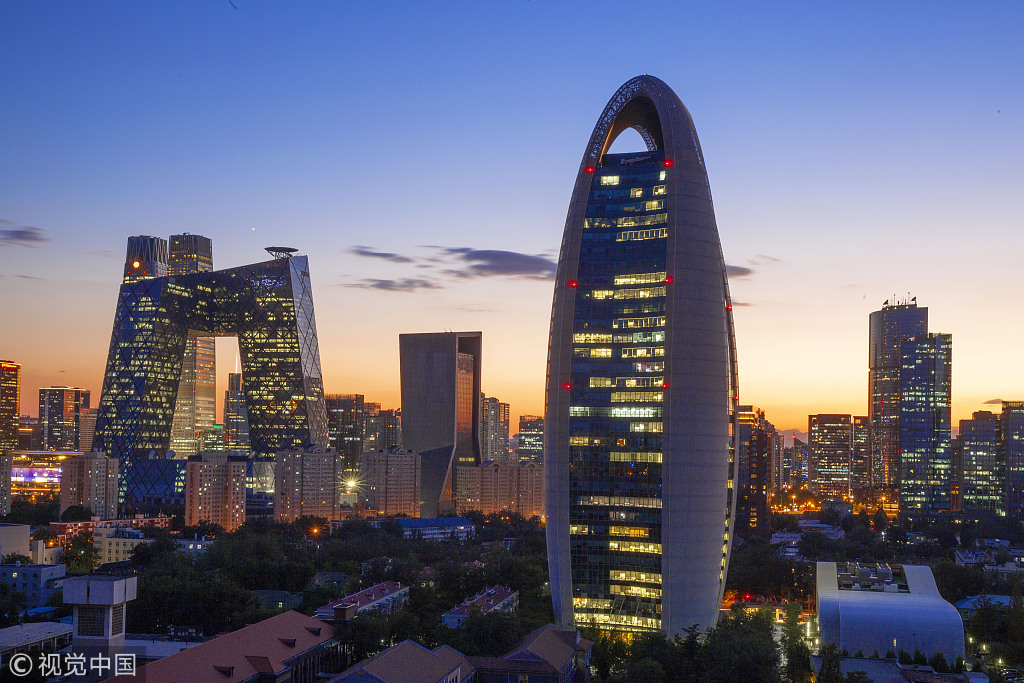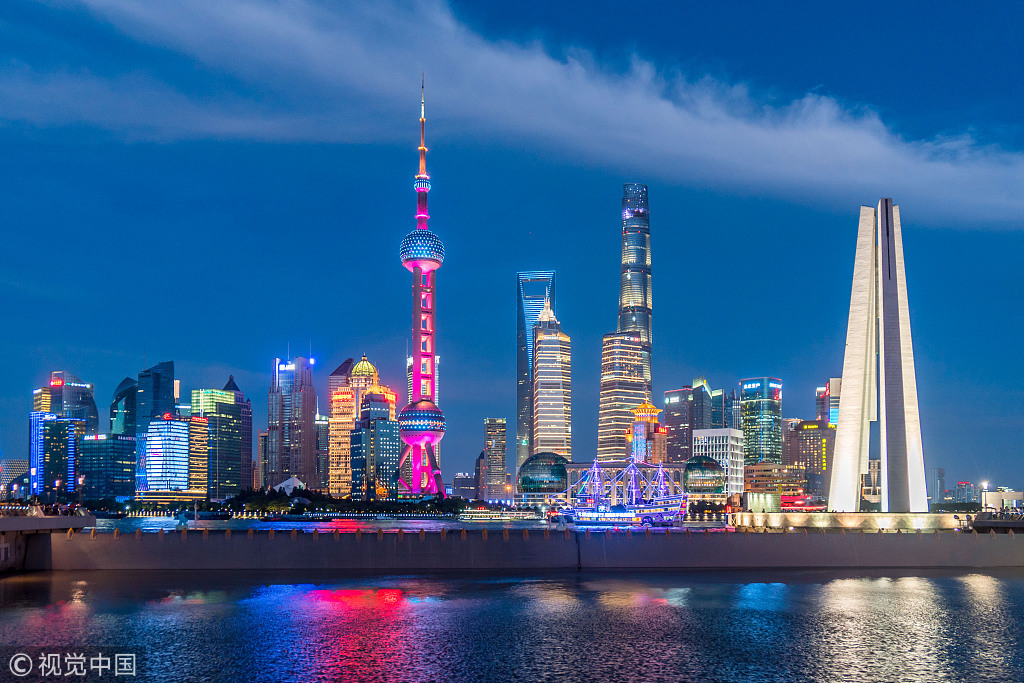China's rapid economic growth is the result of the combination of the world's economic landscape shift and the huge potential unleashed by China's reform and opening up. The Pearl River Delta, the Yangtze River Delta Megalopolis and Beijing-Tianjin-Hebei Megalopolis have become the driving force for China's economic development, as well as China's most international and typical megalopolises. The three megalopolises play a key role against the backdrop of the China-U.S. trade frictions and China's economic restructure.

Beijing's CBD area. (Photos: VCG)
Cloud River Urban Research Institute, a leading think tank for city planning, draws on the 12 sets of data released by the China Integrated City Index 2018 to analyze the performance of the three megalopolises.
(1) GDP
The three megalopolises carry increased weight to China's economy, as they account for 8.6 percent, 19.8 percent and 9.0 percent of the national GDP, respectively, which means 37.4 percent combined. The three megalopolises are obviously the pillar of China's economy.
The performance of the three major megalopolises can be measured by observing the top 30 cities among the nation's 298 cities at prefecture level and above in terms of GDP.
The Beijing-Tianjin-Hebei Megalopolis has two cities whose GDP features in the top 30--Beijing in second place, and Tianjin in sixth.
The Pearl River Delta Megalopolis has nine cities whose GDP making the top 30, including Shanghai in first place, Suzhou in seventh, Hangzhou in 10th, Nanjing in 11th, Wuxi in 13th, Ningbo in 15h, Nantong in 19th, Hefei in 25th, Changzhou in 28th.
The Pearl River Delta Megalopolis has four cities whose GDP ranked in the top 30. They are Shenzhen in third, Guangzhou in fourth, Foshan in 17th and Dongguan in 21st.
The three megalopolises dominate the rankings with 15 in the top 30.
(2) DID Population
Population density is crucial to city issues. The China City Integrated Development Index uses the index of DID (Densely Inhabited District) - districts with a population density of more than 5,000 inhabitants per square kilometer, to analyze population density.
The three megalopolises account for 34.4 percent of the country's total DID population. The Beijing-Tianjin-Hebei Megalopolis accounts for 7.9 percent of the national DID population, the Yangtze River Delta Megalopolis 17.1 percent, and the Pearl River Delta Megalopolis 9.3 percent.
The performance of the three major megalopolises can be measured through observing the top 30 cities among the nation's 298 cities at prefecture level and above in terms of DID population. The Beijing-Tianjin-Hebei Megalopolis has two cities ranked in the top 30--Beijing in second, and Tianjin in fifth.
The Yangtze River Delta Megalopolis has seven cities whose DID ranked in the top 30. They are Shanghai in first, Suzhou in 11th, Hangzhou 13th, Nanjing in 14th, Ningbo in 20th, Hefei in 25th, and Wuxi in 28th.
The Pearl River Delta Megalopolis has four cities whose DID population ranked in the top 30. They are Guangzhou in third, Shenzhen in fourth, Dongguan in ninth, and Foshan in 15th.
There are a total of 13 cities in the three megalopolises making the list of the top 30 cities with largest DID population. However, DID population ratios vary among the three megalopolises, with the Pearl River Delta Megalopolis at 67 percent, much higher than the national average of 31.9 percent, the Yangtze River Delta Megalopolis 46.6 percent, while the Beijing-Tianjin-Hebei Megalopolis only 37.8 percent.

Bright colors glow and reflect on the river in this night view of the Bund in Shanghai.
The three megalopolises are home to more than half of the companies listed on the main boards in Shanghai, Shenzhen and Hong Kong, with the Beijing-Tianjin-Hebei Megalopolis accounting for 15.9 percent, the Yangtze River Delta Megalopolis 28 percent, and the Pearl River Delta Megalopolis 10.3 percent, meaning 54.2 percent combined.
The three major megalopolises can be gauged by the performance of the top 30 cities among the nation's 298 cities at prefecture level and above in terms of the number of companies listed on the main boards.
The Yangtze River Delta Megalopolis has seven cities in the top 30 cities with the most companies listed on the main boards. They are Shanghai in first place, Nanjing and Hangzhou in forth, Ningbo in ninth, Hefei in 13th, Suzhou in 21st, and Wuxi in 24th.
The Pearl River Delta Megalopolis has only two cities in the top 30, including Shenzhen in third place, Guangzhou in seventh. The megalopolis's Dongguan and Foshan, who are well known for manufacturing, are still powered by the "factory economy."
The three megalopolises have 11 cities making it to the list of the top 30 cities with the most companies listed on the main boards. In particular, Shanghai, Beijing and Shenzhen together are home to 31.3 percent of the country's main-board-listed companies.
(4) Chinese Enterprises in Fortune 500
The three megalopolises are home to 80 percent of the country's Chinese enterprises entering the Fortune Global 500 list, with the Beijing-Tianjin-Hebei Megalopolis 54.3 percent, the Yangtze River Delta Megalopolis 14.3 percent, and the Pearl River Delta Megalopolis 11.4 percent.
The performance of the three regions can be measured by observing the top 30 cities among China's 298 cities at prefecture level and above in terms of the number of Chinese companies on the Fortune Global 500 list.
Three cities in the Beijing-Tianjin-Hebei Megalopolis make the top 30, including Beijing coming first, and Tianjin and Shijiazhuang in 11th.
Four cities in the Yangtze River Delta Megalopolis make it into the top 30, including Shanghai in second place, Hangzhou in fourth, and Nanjing and Suzhou in seventh.
The Pearl River Delta Megalopolis has three cities in the top 30, including Shenzhen in third, Guangzhou in fourth, and Foshan in seventh.
The three regions have a total of 10 cities making the top 30. Beijing tops the list, as it has 52.4 percent of Fortune 500 Chinese companies.


